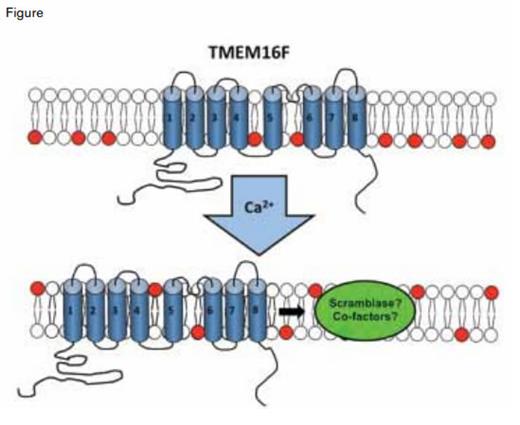In 1979, Weiss et al. described a patient who suffered a moderate to severe bleeding disorder and impaired platelet procoagulant activity.1 The disorder was termed Scott syndrome after Mrs. M.A. Scott, the patient described in the report. A few years later, in 1985, Rosing et al. showed that Scott syndrome was secondary to the inability of platelets to express phosphatidylserine on their surface following activation.2 They subsequently demonstrated a scramblase activity responsible for reversing the asymmetric distribution of phospholipids in the plasma membranes of hematopoietic cells. Like most mammalian membranes, resting hematopoietic cells express neutral phospholipids (e.g., phosphatidylcholine) on their outer leaflet, while phospholipids with negatively charged head groups (e.g., phosphatidylserine, phosphatidylethanolamine) are sequestered in the inner leaflet. Upon activation, a scramblase activity catalyzes the translocation of neutral lipids to the inner leaflet and negatively charged phospholipids to the outer leaflet (Figure). This scramblase activity appeared to be missing in patients with Scott syndrome. But what was the protein responsible for this activity?
TMEM16F: Scramlase or Scramblase Activator? TMEM16F is a Ca2+-activated nonselective cation channel that is required, but may not be sufficient, for scramblase activity in hematopoietic cells. Neutral phospholipids are indicated in white. Phospholipids with negatively charged headgroups are indicated in red.
TMEM16F: Scramlase or Scramblase Activator? TMEM16F is a Ca2+-activated nonselective cation channel that is required, but may not be sufficient, for scramblase activity in hematopoietic cells. Neutral phospholipids are indicated in white. Phospholipids with negatively charged headgroups are indicated in red.
Despite the description of several putative scramblases, the identity of the molecular defect in Scott syndrome remained a mystery for 25 years following publication of the Rosing paper. In 2010, Suzuki et al. identified a constitutively active mutant form of TMEM16F in a subclone of a mouse B-cell line that expressed excessive phosphatidylserine on its surface.3 Depletion of TMEM16F from a mouse B-cell line inhibited activation-induced phospholipid scrambling. In addition, a patient with Scott syndrome was found to carry a mutation in the TMEM16F gene at a splice-acceptor site, leading to premature termination of the protein. Two additional patients with Scott syndrome were subsequently found to have mutations in the TMEM16F gene.4 So, TMEM16F is the elusive scramblase, right?
A recent paper by Lily Yeh Jan’s group at University of California, San Francisco, indicates that the answer may not be so simple. The investigators generated a TMEM16F knockout mouse. The mouse demonstrated impaired, though not absent, expression of phosphatidylserine in response to Ca2+ ionophore. Bleeding time was increased in the TMEM16F-deficient mice and thrombus formation in response to FeCl3 was impaired. In short, the mouse looked a lot like a patient with Scott syndrome. Unexpectedly, however, the authors found that TMEM16F is not a calciumactivated, Cl--specific channel like other TMEM16 family channels, but is instead a Ca2+-activated nonselective cation channel. Heterologous expression of this unusual receptor in HEK293 cells failed to induce any obvious scramblase activity. Endogenously expressed TMEM16F in megakaryocytes was more sensitive to Ca2+ than TMEM16F heterologously expressed in HEK293 cells. Furthermore, scramblase activity was observed in TMEM16F-deficient platelets when exposed to high calcium ionophore concentrations. These observations suggest that additional regulatory factors in hematopoietic cells contribute to TMEM16F-dependent scramblase activity. Thus, TMEM16F may act as part of a larger scramblase complex, rather than as the sole scramblase in hematopoietic cells.
In Brief
The exposure of phosphatidylserine on the surface of activated platelets has long been known to provide a surface for the assembly and activation of clotting proteins. However, the putative scramblase responsible for surface expression of phosphatidylserine has been difficult to pin down. The recent discovery that TMEM16F is the defective channel in patients with Scott syndrome suggested that this channel may represent the scramblase.3 Yet the nature and function of this channel remained undetermined. The study by Yang et al. now demonstrates that TMEM16F is an unusual Ca2+-activated nonselective cation channel that is necessary but apparently not sufficient for phospholipid scramblase activity.
References
Competing Interests
Dr. Flaumenhaft indicated no relevant conflicts of interest.

